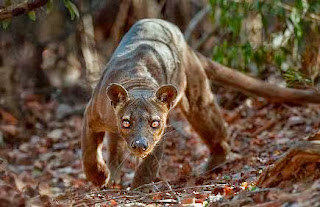
Adult Fossa
The fossa is a cat-like, carnivorous mammal that is endemic to Madagascar. It is a member of the Eupleridae, a family of carnivorans closely related to the mongoose family (Herpestidae).
Its classification has been controversial because its physical traits resemble those of cats, yet other traits suggest a close relationship with viverrids (most civets and their relatives). Its classification, along with that of the other Malagasy carnivores, influenced hypotheses about how many times mammalian carnivores have colonized the island. With genetic studies demonstrating that the fossa and all other Malagasy carnivores are most closely related to each other (forming a clade, recognized as the family Eupleridae), carnivorans are now thought to have colonized the island once around 18 to 20 million years ago.
The species is widespread, although population densities are usually low. It is found solely in forested habitat, and actively hunts both by day and night. Over 50% of its diet consists of lemurs, the endemic primates found on the island; tenrecs, rodents, lizards, birds, and other animals are also documented as prey.

Baby Fossa
Mating usually occurs in trees on horizontal limbs and can last for several hours. Litters range from one to six pups, which are born blind and toothless (altricial). Infants wean after 4.5 months and are independent after a year. Sexual maturity occurs around three to four years of age, and life expectancy in captivity is 20 years. The fossa is listed as "Vulnerable" by the International Union for Conservation of Nature (IUCN). It is generally feared by the Malagasy people and is often protected by their taboo, known as fady. The greatest threat to the species is habitat destruction.
The genus name Cryptoprocta refers to how the animal's anus is hidden by its anal pouch, from the Ancient Greek words crypto- "hidden", and procta "anus". The species name ferox is the Latin adjective "fierce" or "wild."











0 comments:
Post a Comment